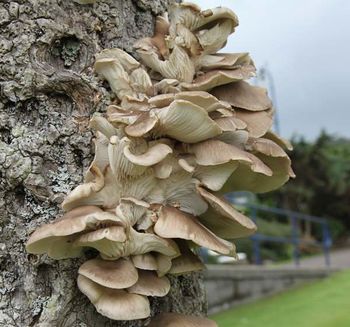Pleurotus ostreatus
Overview

Written by Chris Goodall, Kenyon 22'
Since the commencement of the Anthropocene, humans have continued to produce increasingly significant amounts of conventionally deemed waste products. Ranging from carcinogens to to complex hydrocarbons, the recent accumulation of these synthetic and organic compounds throughout global ecosystems continuously compounds into an ever increasing environmental concern (cite COP 25). Recently, efforts to combat this problematic trend have brought rise to the field of mycoremediation, a a subfield of bioremediation. Mycoremediation works around the concept of potentializing non discriminate fungal enzymes as a means of concentrating, removing, and recycling complex pollutants.
emergence of a new field of science focused on the remediation of these environments. mycoremediation. it's a subfield of bioremediation
At right is a sample image insertion. It works for any image uploaded anywhere to MicrobeWiki.
The insertion code consists of:
Double brackets: [[
Filename: PHIL_1181_lores.jpg
Thumbnail status: |thumb|
Pixel size: |300px|
Placement on page: |right|
Legend/credit: Electron micrograph of the Ebola Zaire virus. This was the first photo ever taken of the virus, on 10/13/1976. By Dr. F.A. Murphy, now at U.C. Davis, then at the CDC. Every image requires a link to the source.
Closed double brackets: ]]
Other examples:
Bold
Italic
Subscript: H2O
Superscript: Fe3+
Introduce the topic of your paper. What is your research question? What experiments have addressed your question? Applications for medicine and/or environment?
Sample citations: [1]
[2]
A citation code consists of a hyperlinked reference within "ref" begin and end codes.
To repeat the citation for other statements, the reference needs to have a names: "<ref name=aa>"
The repeated citation works like this, with a back slash.[1]
Section 1 -- Cellular Structure
niche formation, historical uses, all that good stuff
Include some current research, with at least one figure showing data.
Every point of information REQUIRES CITATION using the citation tool shown above.
Section 2 -- Pleurotus ostreatus: the next heavy metal champion
"Heavy metal pollution due to coal washery effluent and its decontamination using a macrofungus, Pleurotus ostreatus". https://doi.org/10.1016/j.ecoenv.2017.07.001
“Ligninolytic fungi, such as Phanerochaete chrysosporium, Bjerkandera adusta, and Pleurotus ostreatus, have the capacity of PAH degradation. The enzymes involved in the degradation of PAHs are ligninolytic and include lignin peroxidase, versatile peroxidase, Mn-peroxidase, and laccase.” https://doi.org/10.1155/2012/243217
(include some information on inorganic bioremediation)
Include some current research, with at least one figure showing data.
Section 3 -- Pleurotus ostreatus: powered by fossil fuels
“Bioremediation of long-term PCB-contaminated soil by white-rot fungi” doi:10.1016/j.jhazmat.2016.11.044.
- “The best results were obtained with P. ostreatus, which resulted in PCB removals of 18.5, 41.3 and 50.5% from the bulk, top (surface) and rhizosphere, respectively, of dumpsite soils after 12 weeks of treatment”
“Metabolism of phenanthrene by the white rot fungus Pleurotus ostreatus.”
https://www.ncbi.nlm.nih.gov/pubmed/8779594
(include some information on organic bioremediation)
Include some current research, with at least one figure showing data.
Section 4 -- Dyes
literally resistant to other clean up measures and carcinogenic in cases
nope, our mushroom friends said fuck it, i’ll turn that into a fruiting body
Bioremediation of Direct Blue 14 and Extracellular Ligninolytic Enzyme Production by White Rot Fungi: Pleurotus Spp. doi:10.1155/2013/180156
Section 5 -- genome structure?
(talk about what gives it such potential to achieve these remediation strategies?)
Conclusion
References
Authored for BIOL 238 Microbiology, taught by Joan Slonczewski, 2018, Kenyon College.
